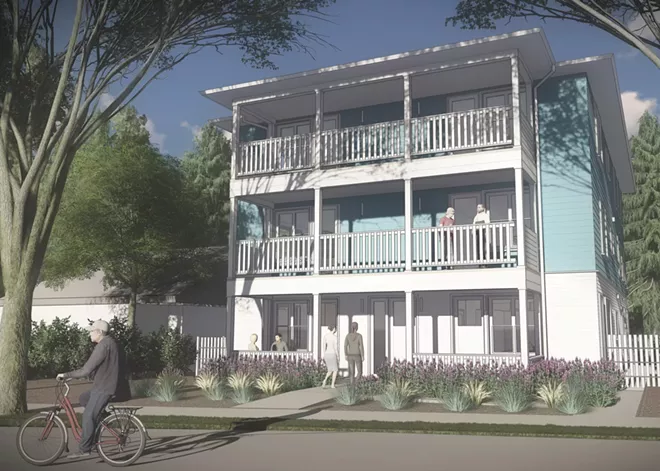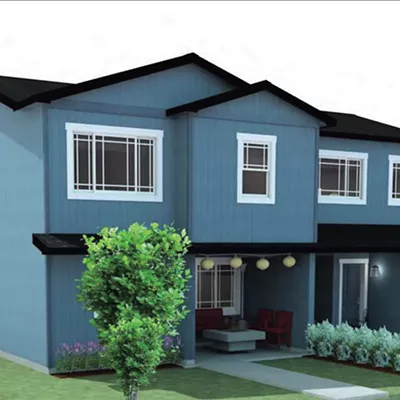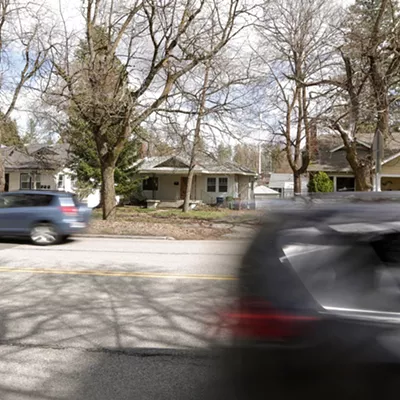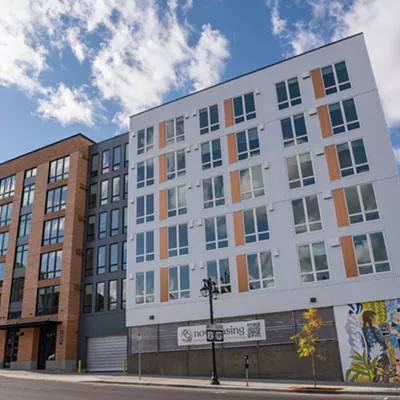
By now you've probably heard about Spokane's middle housing ordinance, which allows new housing types — like triplexes, cottage housing, townhomes and others — across the entire city. The nation-leading legislation passed in permanent form in November 2023 and is now being emulated in cities like Sacramento and even bigger jurisdictions, like in British Columbia. Advocates like myself have argued that these laws create more choices for families and should help slow growth in housing costs.
Now that the law has been in effect for several months (with a yearlong pilot beforehand), we are finally starting to get a picture of exactly what those choices might look like.
For example, last month the Inlander's Nate Sanford profiled Matt Hutchins' "Spokane Six" concept — essentially, a small, six-unit apartment building with two units on each floor. The first one is under construction in the Manito neighborhood, and it features generous balconies and a shared backyard.
Spokane is unique in Washington state in allowing sixplexes and other unique, slightly higher-density housing citywide. Under state law, larger cities are generally required to plan for at least fourplexes (or sixplexes, if two of the apartments are designated as "affordable" units), but most have decided to stop there.
Matt told me that the larger number of units in the "Spokane Six" (pictured above) also allows the development to bear the burden of the higher costs that sometimes work against new development on Spokane's historic grid. A fourplex he had been looking to build nearby was scuttled by a city requirement to improve an alleyway behind the property, which would have been too costly for the project to bear. The sixplex had the same requirement, but with the two additional units, the development was still feasible to build and make some money. And though it wasn't required, two of the six units will be affordable to low- and moderate-income families.
Other developers are taking advantage of the rules to build townhomes — sometimes even "short platting" the land (splitting the lots into smaller ones) so the homes can be sold without need for an HOA. There are almost too many cases to count (and not all will get built, even if issued permits), but a quick scan of our permitting portal reveals projects at various stages of development in Chief Garry Park, South Perry, the North Hill, Hillyard, Manito and many other areas. For those who want the private space of a single-family home with the convenience and efficiency of a condo, townhomes are a fantastic option.
Finally, some property owners are using the rules in creative and unexpected ways — and in unexpected places. Because Spokane's middle housing rules "stack," an owner of a large lot can split the lot and then build multiple units on each of them. While this isn't generally happening in existing neighborhoods, as the lots are too small, it is happening in some of our smaller commercial districts and in places where previously developers might have tried to entitle and build apartments. In other words, the new rules are creating more housing options even outside of our traditionally "single-family" neighborhoods.
Now, it's not all sunshine and rainbows: We still have a good amount of work to do.
For example, the city could evaluate the frontage, alley, and other improvement requirements it places on development, along with its impact fees. These requirements — a repaved sidewalk here, a paved alleyway or utilities improvements there — build valuable amenities for residents, but the costs can add up quickly. Matt Hutchins' doomed fourplex project, for example, would have required almost $100,000 in improvements related to an alleyway. We need to consider whether each of these costs are truly necessary and whether property owners alone should foot the bill.
Going further, the city could provide preapproved building plans for property owners to build middle housing on their land. It could even work to educate contractors and builders on these plans, making the building process for a property owner as simple as possible. Perhaps it could form partnerships to provide easier access to high-quality building materials, like mass timber.
Then there are the state-level problems, like condo liability reform, which would better enable the units in projects like the "Spokane Six" to be sold individually. Fortunately, some of these improvements are already in the works, both in the state Legislature and at City Hall. Indeed, if we're going to solve our housing affordability crisis, we need to get creative and think big.
Personally, I'm glad that both our development community and our policymakers are throwing everything at the wall. ♦
Anthony Gill is an economic development professional and writer of Spokane Rising, a blog about ways to make our city a better place to live.





















